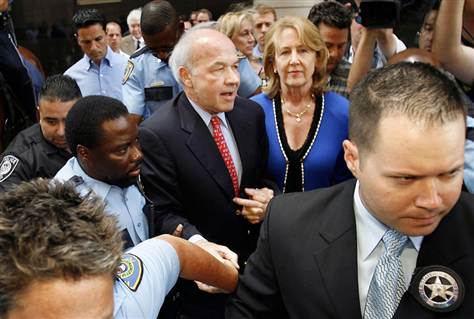
The father of irrational exuberance. If Bush had just yanked his hands down, a lot of problems could have been avoided
Huge, breaking, earth-shattering, paradigm-shifting, cliché-inspiring news this week, as the Dow Jones Industrial Average finally pawed its way back over the critical 7634 mark. No longer will we have to suffer in a world where the sum of the prices of 30 blue-chip stocks multiplied by a constant will begin with 7-6-2 or some lesser string of digits. Instead, let’s all stop at this milestone and take a needed respite.
Oh, sorry. Yeah, we were using base-12. Would you prefer we used base-10? Fine, but we’re going to use a different currency, euros. Which would make the Dow level 9807. No wait – let’s use base-12 and euros. That’d make the Dow level 5813. Isn’t this fun?
Most of the stock market “news” results from humans having 5 fingers on each hand and needing a way to count things. There isn’t any appreciable difference between a Dow at 12,999 and a Dow at 13,000, except that the latter burns a different array of bulbs in a digital readout and gives mathematically challenged journalists a chance to write headline fodder. Stop believing that this is in any way important.
From our favorite purveyors of loaded rhetoric, the Associated Press:
The Dow passed 13,000 about two hours into the trading day.
And from another AP story:
The average was above 13,000 for about 30 seconds before dropping back. It reclaimed the mark just after noon.
In the words of Anti-Nowhere League, “So (expletive) what?” They’re talking about this like it’s the moon landing, calibrating the event by time and duration so future generations will have a historical record of it.
Furthermore, the mere addition of one point to the Dow then becomes the catalyst for everything that follows. One more AP story, and a stunning example of why reading the news with a trusting eye is worse than not reading it at all:
The 13,000 level is a psychological milepost, but in a market built on perception, it could influence more cautious investors to pump more money back into the stock market, analysts said.
“You need notches along the way to measure things, and that’s as good as any,” said John Manley, chief equity strategist for Wells Fargo’s funds group…
Dan McMahon, director of equity trading at Raymond James, called the 13,000 marker a “positive catalyst, and that’s what we need to get us through the next range.”
Sounds like these Wall Street guys are as susceptible to “decimal bias” as the rest of us, right? No. McMahon continues:
In the end, he said, it’s just “a big round number.”
Which shows that the claims that “analysts said…it could influence more cautious investors to pump more money back into the stock market” is an unmitigated lie. Or if not a lie, then at least an unprovable assumption. Sure, Dow 13000 “might” influence investors to buy stocks. It also “might” turn the milk in your fridge sour. You don’t think so? Then show why it can’t.
CBS News has a video clip with the wonderfully objective title: “Dow 13,000: Time to Invest?”, which itself summarizes why financial illiteracy is pandemic. Yes, first let’s overpublicize a rise, however modest, in the Dow level. Then, let’s imply that people should buy stocks. Because that’s when you want to buy, when prices are rising.
You want superlatives? The Dow is now at its highest level since May 2008. When the Dow was at 12,990, that was its highest level since…May of 2008. Add the inexorable effects of inflation, however modest, not to mention whatever fees you paid for your index fund, and if you’d bought before May of 2008 you’d still be behind. If, however, you were dollar-cost averaging and buying units regularly since then, including when the market hit a local nadir of 6627 in March 2009, you’d be ahead. The Dow’s most recent movements, i.e. what it’s done in the past week, mean nothing.
We’ve talked early and often about the need to handle your financial transactions in a cold, calculating manner. Save the emotion and the irrationality for your personal, non-monetary life. When everyone else is chasing something, step back and ask why. When everyone else is fleeing something, same thing. And when a numerical quirk becomes front-page news, bumping Iranian oil embargoes to the second line, think about what that really means. To the extent that it means anything.
Yet another reason why our use of exclamation points on this site is so judicious. If a bunch of talking empty heads filling time in a TV studio have somehow convinced you that a .06% rise in the Dow is a reason to get your money out of your beer fund and put it towards stocks, we can’t help you. Besides, you don’t want to be helped.
There’s a time to get going, and a time to sit back (apologies to St. Francis.) If you don’t have an investment plan yet, run to the nearest brokerage house, bank, or human resources office and get one. It’s never too early to start.
But once you’ve invested, which we’re presuming you have, don’t drown in the details. Try to look at your portfolio quarterly. That recommendation is like Tolstoy’s challenge to not think of a white bear, but if you can do it, you’ll not only have greater peace of mind, you’ll be able to notice measurable differences in your portfolio more easily. It’s the same reason why parents marvel at how quickly their nieces and nephews grow, rather than how quickly their own kids do.
Getting excited, depressed, or even having an opinion about Dow 13,000 is mayfly syndrome. But you’re a human, with a lifespan tens of thousands of times longer than your typical mayfly. Even a giant daily swing in the Dow is utterly irrelevant, let alone one of just a few points.
This article is pick of the week in:
**Top Personal Finance Posts of the Week-Cutest Kids Ever Edition**





